- By Dan Veaner
- Around Town
 Print
Print 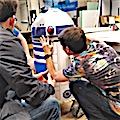 Last month Cornell systems engineering students opened the engineering maker lab to Lansing physics and robotics students for a hand-on afternoon with some familiar robots... and some not so familiar ones. The lab is responsible for the Intel-Cornell Cup embedded design competition, which challenges college students to invent new, innovative applications of embedded technology.
Last month Cornell systems engineering students opened the engineering maker lab to Lansing physics and robotics students for a hand-on afternoon with some familiar robots... and some not so familiar ones. The lab is responsible for the Intel-Cornell Cup embedded design competition, which challenges college students to invent new, innovative applications of embedded technology. "When you think of Cornell engineering students tinkering away in some basement lab, this is it! The Systems Engineering Lab located in the basement of Carpenter Hall is a 'makers' paradise," says Cornell University Engineering PR and Content Manager Syl Kacapyr.
The Intel-Cornell Cup competition offers student teams an opportunity to win up to $7,500 for inventing embedded technology applications. The lab tries to identify areas that universities are not covering, gaps in systems design, that the competition projects can address. Teams compete from all over the United States, and additional competitions are held around the world. This year the competition is being held online only to eliminate travel costs and make the competition accessible to more students.
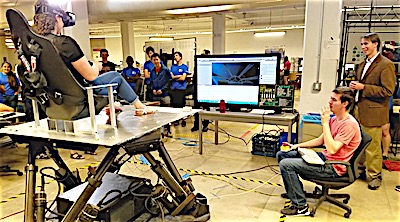 A Lansing High School student drives a Star Wars pod racer. All photos courtesy of Syl Kacapyr.
A Lansing High School student drives a Star Wars pod racer. All photos courtesy of Syl Kacapyr.Lansing students were invited to the lab, directed by Associate Director of Systems Engineering Dr. David Schneider, to experience a handful of projects, including what Schneider believes is the first successful integration of MOOG 6 degree of freedom motion platform and an Oculus Rift VR headset. If you didn't understand what that is, its a Disney-inspired Star Wars pod racing theme park ride. The virtual reality goggles are coordinated with a hydraulic system to make the operator feel like she or he is actually inside the vehicle, speeding around a planet.
"Why the heck would we build such a thing? It actually turns out to be a really good engineering problem," Schneider says. "Aside from that we were able to highlight the importance of performance and validation testing throughout the design process. I could give you a guide on how to do that, or I could say, 'here's a case study about how a bunch of crazy Cornell students invented this theme park ride.' If you're a student, which one are you more likely to read?"
That is the point -- to take serious, complicated design applications and make them fun and challenging while forcing student teams to solve engineering and design problems in interesting and new ways.
Then students visited a number of stations where they could try out or drive robots. They got to talk with undergraduates and Master of Engineering students about projects that included an R2-D2 robot and his buddy C3P0, ModBot V2, MiniBot, and a rehabilitation device.
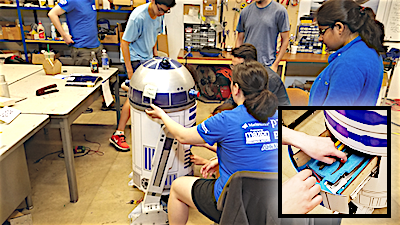 This R2D2 has an embedded drawer (inset) from which it delivers tools to students working in the lab. It even has a limted beeps and whistles language it uses to speak to people, and uses voice recognition to understand them.
This R2D2 has an embedded drawer (inset) from which it delivers tools to students working in the lab. It even has a limted beeps and whistles language it uses to speak to people, and uses voice recognition to understand them.The R2-D2 robot is used as a functioning lab assistant, using a built-in inventory system to be able to bring lab members tools and parts. It has an onboard navigation system to help it find its way around the lab. It also speaks a limited language of whistles and beeps that students in the lab learn, and uses voice recognition to respond to their commands.
"He's got a very basic language of beeps and whistles just like in the movie when Luke is able to talk to R2 and somehow understand what he is saying," Schneider explains. "You can do that to a limited extent with our R2, but we hope to grow that some."
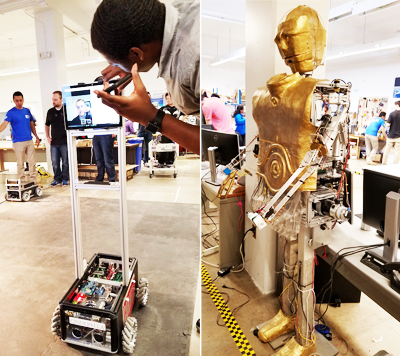
ModBot is a modular robotics system the lab has been developing for several years. The idea is to provide a robotics system that is about 1/10 the cost of typical robot kits to be used by freshmen and sophomores ain college, and potentially by high school groups. The lab is working with a startup company called Socially Shaped to create a product. Schneider says the smaller version may only cost about $300. The prototype was finished this year, and he says he hopes a production version, developed in partnership with a startup company called Socially Shaped, will be completed next year.
"It's a real robot," he says. "It's not like some of the education kits where you can do it in spirit but not really get down to what actually makes it a robot. We're trying to provide a system where if you want to work on just one aspect of it you can, but we'll make it easier to work in those other areas. We've analyzed other packages, and really tried to come up with ways to validate our system as definitively better than the ones that are out there. It's a really great research platform, and we're coming out with the newest version this year."
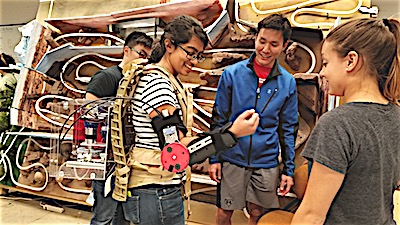 Patients normally have to use rehabilitation equipment like this robotic arm at a hospital, but students made the whole thing fit into a package the size of a back pack so patients could potentially use the technology for physical therapy at home.
Patients normally have to use rehabilitation equipment like this robotic arm at a hospital, but students made the whole thing fit into a package the size of a back pack so patients could potentially use the technology for physical therapy at home.Schneider says some of what is developed in the lab can be used by high school students. Local robotics teams have worked with the lab in the past, going on to win awards. The Lansing robotics team came to Cornell last Fall, then went on to win an award for their design work.
"The projects that have come out of the Cup have been remarkably high caliber," he says. "One team took their entry from the Cup and entered it to become the first American group to win the James Dyson Award for Engineering and Design. Another participant was named one of Forbes Magazine's 30 Under 30."
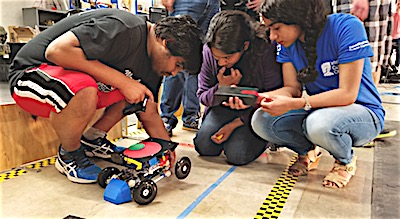 This robot can navigate without an operator, learning as it goes along.
This robot can navigate without an operator, learning as it goes along.The lab also produced the MiniBot, which careened around the lab. It learns as it goes along, navigating without an operator.
"A real world application would be for search-and-rescue efforts where responders need to map out an environment before entering," Kacapyr notes.
The competition, not open to Cornell teams, is all about learning and innovating. The lab produces guides on various topics that are made available at no cost to anyone who wants to learn about an aspect of embedded technology. Some funding is provided, but teams are allowed to do their own fundraising to augment their project budgets. Live online information sessions are held. The best projects move on to the semifinals, and then the finals.
Johns Hopkins University won this year's competition with GEAR (Game Enhancing Augmented Reality) bio-gaming device, shoes that aid video game players who are missing arms to control movement with their feet. The 2015 winner was the Worcester Polytechnic Institute team's WALRUS Rover. WALRUS stands for Water and Land Remote Unmanned Search, a rover to be used in search and rescue applications.
"These are skill sets or curriculum gaps we've noticed across the country, and even the world," says Schneider. "We really want to address them because, even if you're not an engineer, these are essential design skills that anybody should try to make part of their design ethos. We're hoping it will have far greater ripple effects and help solve major kinds of problems using these techniques."
v12i23



